
Dragon Teeth, In order to cut the flesh of their prey
Dragon teeth symbolize strength, protection, tenacity and mystery. In Greek mythology, Jason planted dragon teeth in the ground, and these dragon teeth turned into armed warriors; in fantasy novels, dragon teeth are used to make powerful magic weapons; in games, dragon teeth are used as materials for making powerful potions and magic items…
It exists not only in the world of fantasy, but also in the real world. There is an anti-tank obstacle called Dragon’s Tooth, which is a solid concrete structure used to block the attack of enemy tanks and armored vehicles.
It is hard to say whether the teeth of other dragons are hard or not, after all, neither Eastern dragons (loong) nor Western dragons (dinosaurs are another matter) can be found in the real world. But there is a kind of “dragon” called Komodo dragon, which has been scientifically proven to have really hard teeth, because there is something “unusual” in its teeth.
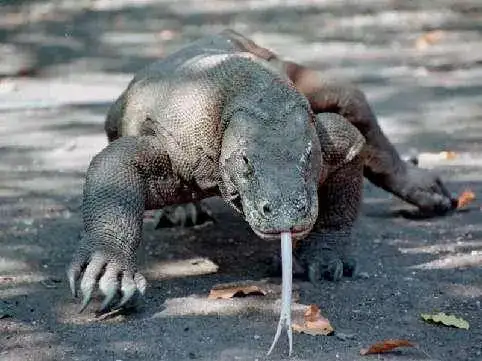
Giant lizard Komodo Dragon
The giant lizard Komodo Dragon lives on Komodo Island in Indonesia. It is professionally known as the Komodo Dragon (Varanus komodoensis). It is the largest lizard on earth (male Komodo Dragons can be up to 3 meters long) and is known for its huge size and deadly hunting skills. Its name has a long history. In 1912, the first Dutch expedition landed on this small island in Indonesia and brought back several “monsters” that were shot and named them Komodo Dragons.
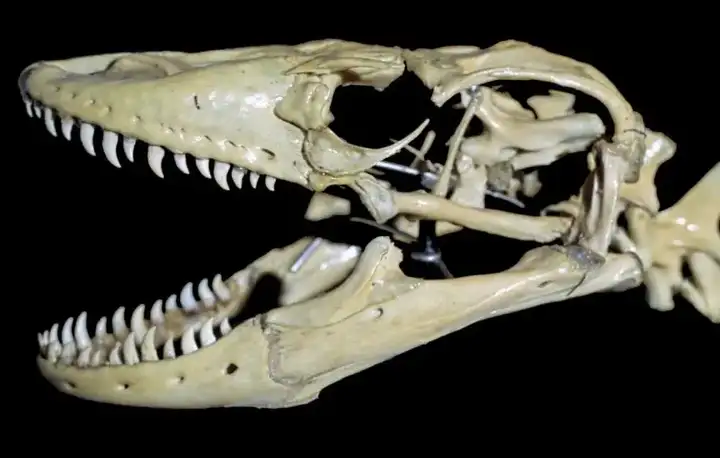
Previous studies have shown that Komodo dragons are venomous, with MRI scans of their skulls showing the presence of two venom glands in their jaws. However, little is known about their fangs.
Aaron LeBlanc and his research team collected Komodo dragon tooth samples from various natural history museums and zoos. These samples included bone specimens and teeth preserved in liquid. Scientists found that these teeth not only have serrated edges, but are also covered with a unique orange coating.
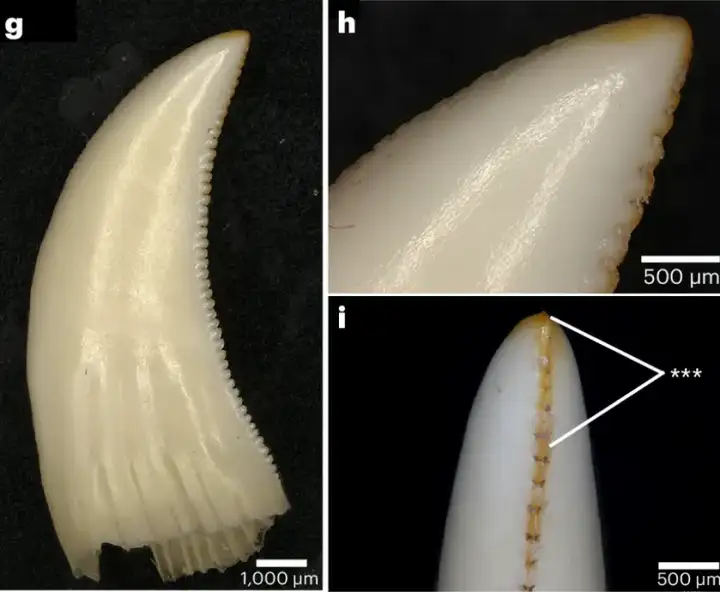
This orange color is evident not only on the functional teeth but also on the replacement teeth, suggesting that the orange color is not a result of staining from eating.
Functional teeth
Functional teeth are teeth that are currently in use and perform actual functions. Replacement teeth are spare teeth that have not yet replaced functional teeth. For Komodo dragons, their new teeth usually begin to develop at the roots or sides of old teeth. As the new teeth mature, they push the old teeth out and eventually replace them. This process ensures that the Komodo dragon always has a fully functional set of teeth.
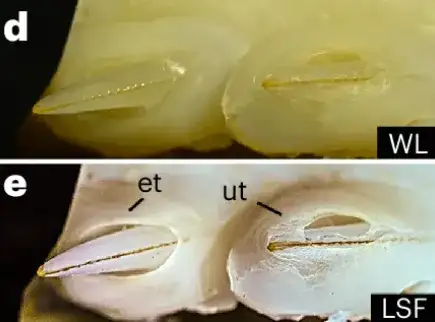
Next, the team used scanning electron microscopy (SEM) and energy dispersive spectroscopy (EDS) to conduct a detailed analysis of the tooth samples. They fixed the samples with resin and processed them under a vacuum environment. The samples were cut into thin slices for easy microscopic observation. In the SEM images, they clearly saw a bright coating on the surface of the teeth, which was an iron-rich coating with a thickness of about 1-2 microns.
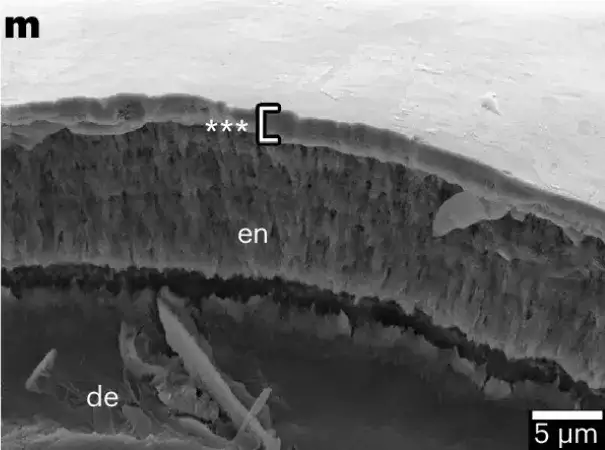
To more precisely determine the composition of the tooth coating, the team used synchrotron X-ray microfluorescence spectroscopy (S-µXRF) and microdiffraction (S-µXRD) . These techniques helped them confirm that the iron in the tooth coating was mainly in the form of hexahydrated iron oxide , which has also been found in the tooth coating of some rodents, such as the orange front teeth of tree-gnawing beavers.
See below for beaver teeth
Finally, to measure the hardness of these iron coatings , the scientists performed nanoindentation tests , measuring the hardness and elastic modulus of different parts of the teeth .
In the nanoindentation test, the average hardness of the orange coating area was measured at 6.8 ± 0.3 GPa ( Gigapascals ), and the elastic modulus was measured at 110 ± 5 GPa. The average hardness of the enamel area without coating was measured at 6.0 ± 0.2 GPa, and the elastic modulus was measured at 100 ± 4 GPa. The results show that the presence of the orange metal coating does enhance the hardness and rigidity of the teeth, giving the Komodo dragon an advantage in hunting and tearing prey.
Taking humans as an example, according to previous studies, the average hardness of human enamel is 4.5±0.5GPa , and the average elastic modulus is 100±10GPa . It can be seen that with the metal coating, it is indeed much stronger, at least in terms of hardness.
Why can iron hydroxide coating enhance the hardness of teeth?
According to the previous SEM and EDS analysis, the iron hydroxide in the coating is evenly distributed and tightly bonded to the enamel. This shows that when the iron hydroxide is deposited on the tooth surface, a strong interface bond is formed between these particles and the enamel. This interface bond enhances the adhesion of the coating to the tooth matrix through chemical bonds and physical intercalation, thereby improving the overall mechanical strength.
Do other lizards have orange iron coatings on their teeth?
Scientists have investigated the teeth of several species of monitor lizards (Varanus) and lizards (Heloderma), including extinct ancient monitor lizards. The figure below is a phylogenetic tree showing the evolutionary relationships between different monitor lizard species. Photos of the teeth of each monitor lizard and lizard. Red branches represent species with obvious and persistent tooth marginal pigments ; black branches represent species with no obvious pigments; blue branches represent species with occasional or inconsistent pigmentation in their teeth; orange branches represent species with unknown pigmentation levels due to fossilization.
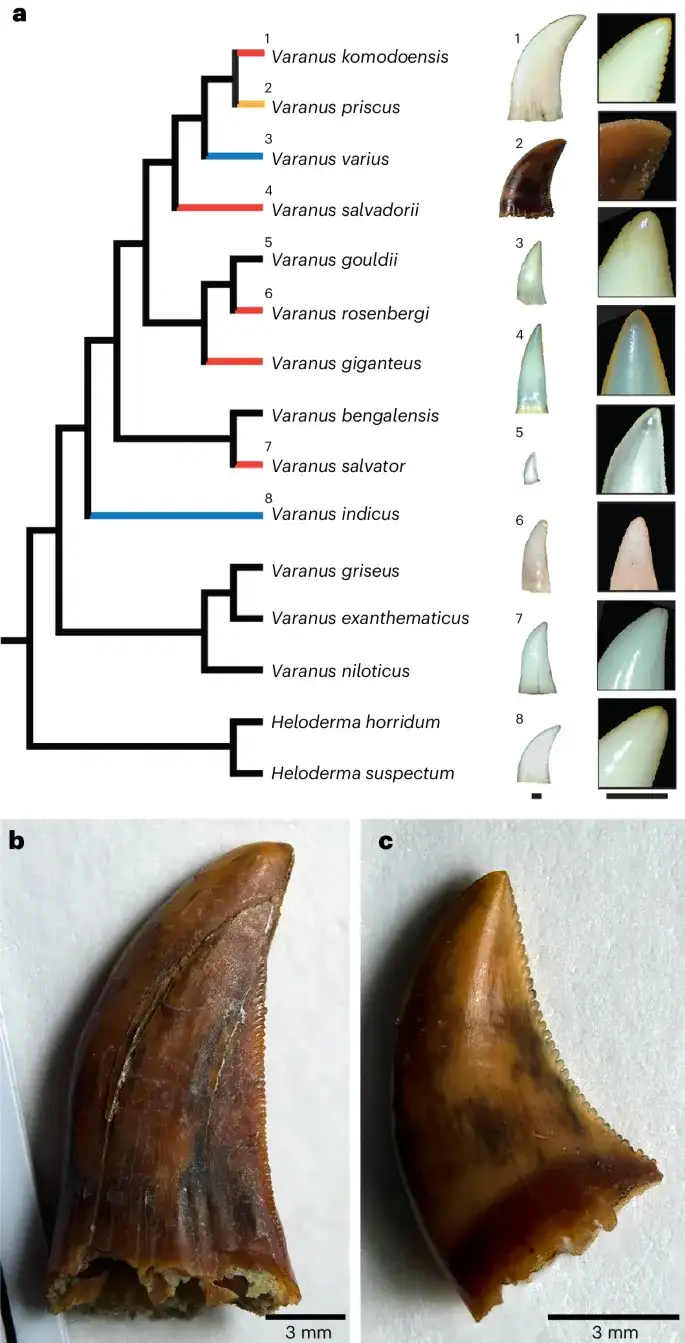
From this we can see that there are quite big differences in teeth between lizards. But they generally have serrated structures.
Aaron Loeb had thought about this before he did his experiment. He got the fallen teeth of several different crocodiles from the zoo. The fossil teeth of crocodiles from the Late Cretaceous period from Dinosaur Provincial Park in Alberta, Canada.
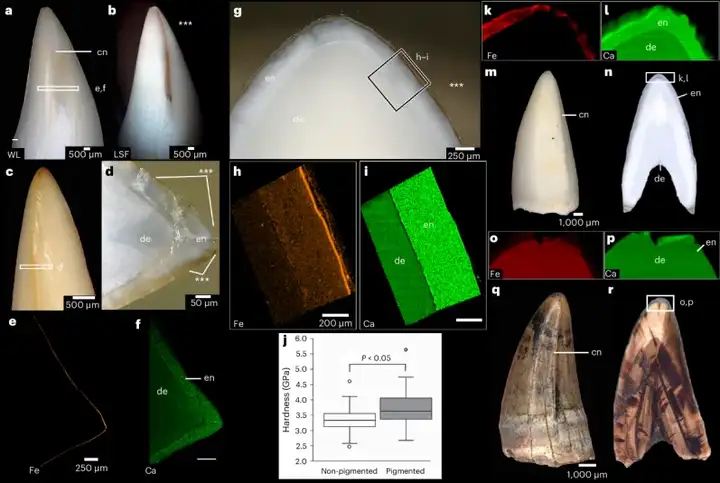
The results for crocodile teeth were not exactly the same as for Komodo dragons.
In common, crocodile tooth samples also showed an iron-rich signature. However, the coating was not evenly distributed on the tooth surface. It was not as thick as that of Komodo dragons. Further LA-ICP-MS analysis revealed increase concentrations of iron and calcium in the dentin of crocodile teeth. But no significant increase in iron concentration was observed in the outer enamel.
In the fossil crocodile tooth samples (q, r in the figure above). The calcium and iron signals in the dentin are significantly enhanced. But no significant iron coating is seen in the enamel. This may be because the fossilization process obscures these features. It is hard to say. In general, although they are all large reptiles and are all fierce guys. The iron-rich coating has significant differences in structure and chemical composition.
What about the dinosaurs?
Unexpectedly, scientists also got the teeth of Tyrannosaurus and Dromaeosaurus! After observing the microstructure of their teeth, they found that there was no significant iron deposition on the serrated edges of Tyrannosaurus teeth. The iron was mainly concentrated in the dentin area inside the teeth, but the signal was not very obvious. In addition, the enamel of Tyrannosaurus was wavy. Which may prevent crack propagation through complex microcrack paths. Thereby enhancing the durability of the teeth.
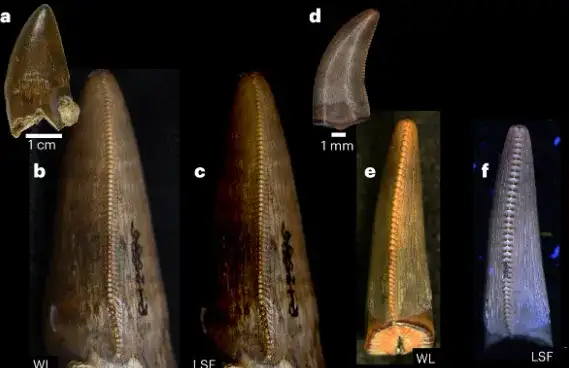
No significant iron signal was detected on the serrated edges or inside of the teeth of Dromaeosaurus. Moreover, the enamel of Dromaeosaurus teeth is relatively simple. Mostly parallel crystallite enamel, which has a simpler structure than the wavy enamel of Tyrannosaurus teeth.
Neither Tyrannosaurus nor Dromaeosaurus teeth show significant iron deposition, in stark contrast to the iron coating in Komodo dragon teeth. It could be that the fossilization process obscured the signal. Or that these dinosaurs did not have this adaptation in their teeth.
Although no iron coating was found. According to tests, the enamel and dentin of Tyrannosaurus are twice as hard as the corresponding areas of Komodo dragons and Mississippi alligators. This may be the effect of fossilization. So it is hard to say how hard the teeth of living dinosaurs are. But they are definitely hard, at least harder than human teeth, after all, the microscopic structure is there.
Dragon teeth are really hard! They are worthy of being the top predator!


One thought on “Dragon Teeth, In order to cut the flesh of their prey”